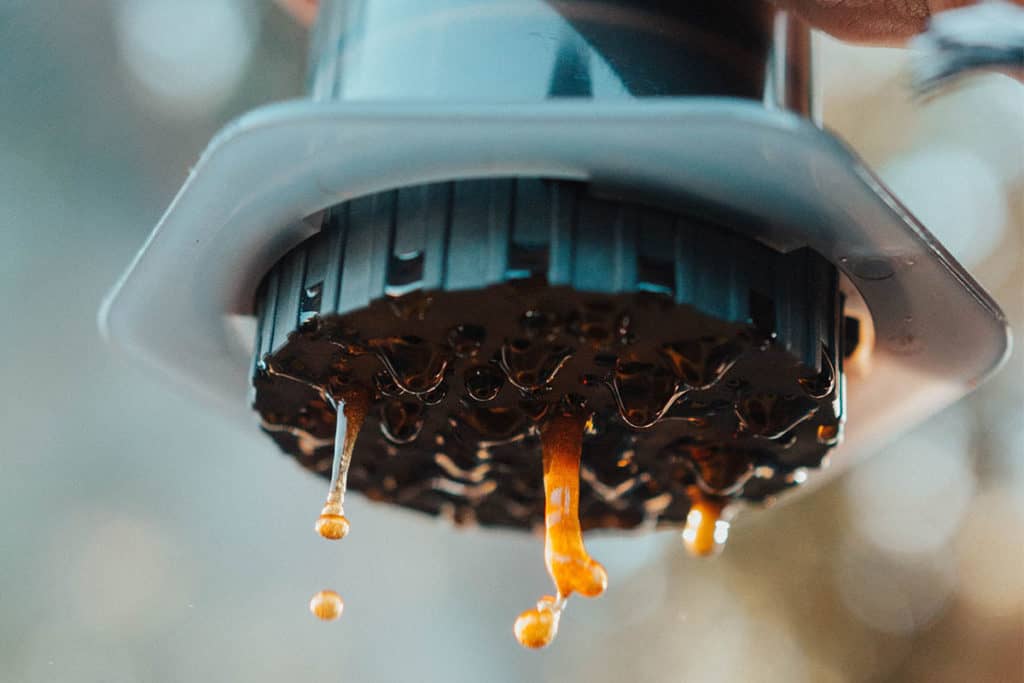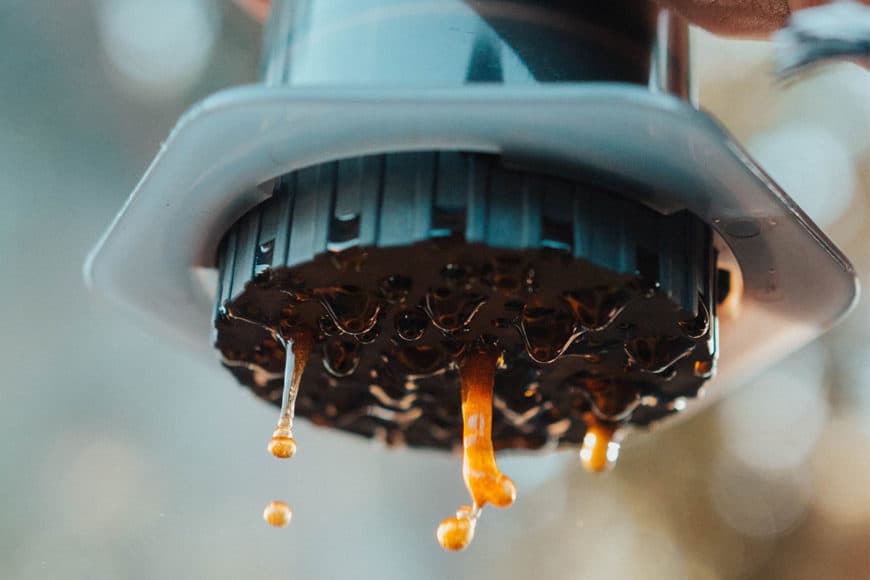
If you are a coffee enthusiast and enjoy experimenting with various brewing methods at home, then you have heard of the Aeropress. Invented in 2005, the Aeropress took the coffee world by storm. Its innovative and simplistic design has won over the hearts of many home brewers, outdoor enthusiasts and professional barista
Brewing coffee with a Aeropress is easy to do regardless if your brewing a cup at home or on the road. Whether you choose to brew using the standard, inverted or espresso method, this Aeropress brew guide will help you get a clean and flavorful cup of coffee every time.
3 Easy Ways To Make AeroPress Coffee
If you think about it, the Aeropress and an electric coffee machine use the same principle: pressure. The only difference is that with the Aeropress you don’t need electricity, just your hands.
This not only make it easy to use, it also adds to its versatility. It is currently the only brewer that can be used in many different ways and achieve different cup profiles depending on your taste.
1. Standard Brewing Method
The standard method is the suggested method described in your Aeropress instructions kit. This is how its inventor imagined that people would use his brewing device.
Essentials
- 17g Fresh Roasted Coffee (Local if Possible)
- Filtered water
- Paper or Metal Filter
- Grinder
- Scale
- Timer
- Aeropress stirrer (included in your kit)
Step By Step Guide For Standard
Step 1. Heat 250g of water to 175 F
Step 2. Weigh 17g of coffee and grind medium fine
Step 3. Put Coffee in Aeropress
Step 4. Add Water to Coffee
Step 5. At 2:00 minutes press down slowly
Step 6. Remove Aeropress and Enjoy
Once you’re comfortable brewing with the standard method, you can try the inverted one and compare them. Brewing with an Aeropress is easy but because it’s relatively novel I suggest you try it at least three times before you can judge the result. By the third time you’ll realise it’s quite simple.
2. Inverted Brewing Method
After three years of its launch, the Aeropress started becoming very popular with professional baristas, who in turn started experimenting with it and came up with the inverted method.
The difference lies in the positioning of the chamber. When using the standard method, you screw the filter cap on the chamber and place the chamber on top of your mug. After that you’re basically ready to add coffee grounds and hot water, plunge it down and there is your cup of coffee.
The inverted method requires you to place the plunger just at the top of the chamber and turn the whole thing upside down. Now, the part of the chamber where you screw your filter is at the top. You then need to add coffee grounds and hot water until you’ve reached the desired level, screw the filter cap back on and invert the aeropress on your mug.
Plunge down and your coffee is ready. By placing the plunger at the top of the chamber during the first step, you create a vacuum that traps the coffee grounds and the hot water. Many professional baristas believe that they can exercise more control over their brew by creating this vacuum.
Essentials
- 17g Fresh Roasted Coffee (Local if Possible)
- Filtered water
- Paper or Metal Filter
- Grinder
- Scale
- Timer
- Aeropress stirrer (included in your kit).
Step By Step Guide For Inverted Method
Step 1: Heat the water at 175 F and measure 17g of coffee beans.
Step 2: Grind the beans using a medium to fine grind setting.
Step 3: Put the paper filter in the filter cap and screw it at the bottom of the chamber.
Step 4: Place the chamber on top of your mug and add the ground coffee.
Step 5: Transfer the mug with the chamber on your scales and grab your kettle.
Step 6: Start your timer and begin adding hot water, aiming for 2 minutes a total of 250g.
Step 7: Stir the brew slowly a few times in order for all the grounds to come in contact with the hot water.
Step 8: Grab the plunger, insert it in the chamber and start pushing down slowly.
Step 9: Once you’ve plunged down all the way and your coffee will be ready.
3. Aeropress For Espresso
When Alan launched his product and started promoting it at coffee events in the U.S., he presented it as a brewing device that can also make espresso, not just filter coffee. This was controversial as no other brewing device had achieved making anything close to an espresso drink apart from the moka pot.
Professional baristas doubted this fact and so Alan set up a blind tasting between a coffee machine espresso and an Aeropress one. Evidently, some baristas chose the Aeropress espresso over the machine made one and so began the experiments.
Today, many people use the Aeropress to make an espresso drink, so let’s have a look at how you can do it at home:
Essentials
- 20g Fresh Roasted Coffee (Local if Possible)
- 100g Filtered water
- Paper or Metal Filter
- Grinder
- Scale
- Timer
- Aeropress stirrer (included in your kit).
Step By Step Guide For Espresso Brewing
Step 1: Heat the water at 195 F and measure 15g of coffee beans.
Step 2: Grind the beans using a fine grind setting
Step 3: Put the paper filter in the filter cap and screw it at the bottom of the chamber.
Step 4: Place the chamber on top of your mug and add the ground coffee.
Step 5: Transfer the mug with the chamber on your scales and grab your kettle.
Step 6: Start your timer and begin adding hot water until you get to 100g
Step 7: Shake the Aeropress in a circular motion to cover all the grounds with water.
Step 8: When your timer reaches 30 seconds, stir gently then insert the plunger
Step 9: At 1 minute plunge all the way and your espresso will be ready.
Needless to say that an Aeropress espresso is not as intense and concentrated as a true espresso brewed with a professional coffee machine, but it comes close enough to fool a few baristas.
The great thing about being able to brew an espresso with the Aeropress is that you can then make other espresso-based drinks such as cappuccino, latte, flat white, cortado etc.
Important Aeropress Variables
Brew Time
The fact that the coffee and hot water are trapped in a small chamber allows for quick extraction. This means that your overall brew time will be short, usually 2 minutes.
Grind Setting
The reason you need to grind your beans on a medium to fine grind setting is because the finer the grounds, the quicker the extraction. You have about two minutes to extract the coffee, so if you were to grind coarse your brew would taste very weak, almost tea-like.
AeroPress Filters
Paper or metal filters? Well, it depends on how you like your coffee. If you want a clean cup of coffee without sediment then use the paper filters. Paper has the ability to absorb the natural oils of the coffee grounds.
If you prefer a heavier cup with some sediment then use the metal filter, so that the natural oils will be added to your cup. The Aeropress kit includes 350 paper filters but you would have to buy the metal one separately.
One other thing to note about the Aeropress is the volumetric reference numbers on its side. You will notice there are numbers from 1-4 and they correspond to the number of servings you can make. You don’t necessarily need to use these, you can just brew it by mass, but it’s an option.
If you’re making coffee for a few people, instead of using the whole brew to make one cup of coffee, you can distribute it in four cups based on the numbers and just add extra hot water at the end according to taste.
Final Thoughts
It is easy to understand why the Aeropress has become so popular. It’s simple design, smart technology, portability and overall versatility has made it an object for experimentation for many coffee lovers and professionals.
Its ease of use has also made it a camper’s favorite brewing device and you will often see photos of people brewing with the Aeropress on top of mountains. All in all, I definitely recommend giving the Aeropress a chance, it might just make your cup of coffee even tastier. Be sure to share your results with me and enjoy brewing with it!

